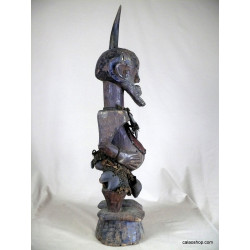Songye fetish statue
The Songyé fetish statue derives its power from its many accessories but also from the horn that tops it: The exterior of the horn is supposed to represent the masculine concept, while the interior symbolizes the feminine….
-
 Secured payment
Secured payment
-
 Free shipping from 150 €
Free shipping from 150 €
-
 Guarantee "satisfied or refunded"
Guarantee "satisfied or refunded"
Very beautiful fetish statue in wood, metal and various, typical of the Songyé ethnic group of the DRC
It measures 85 cm high; age cracks and losses (see photos)
The Songyé ethnic group
The Songyé are settled on the left bank of the Lualaba River, on a plateau covered with savannah and forests. Divided into many clans or subgroups, the four hundred thousand Songyé are governed by a central chief, the yakitengé, whose function requires that he not show strong emotions, not have physical contact with the villagers and not drink in public. Local chiefs, the sultani ya muti, distribute land to the villagers and a powerful secret society, the Bwadi Bwa Kifwébé, counterbalances their power. Songyé society is patriarchal and agriculture is their main economic activity.
Songye Art
The Songye have created impressive statues, often covered with numerous accessories and masks, with powerful features, used during ceremonies related to their secret societies.
Songye Masks
The best-known mask, called kijwebe, is worn by members of the secret society Bwadi Bwa Kijwebe; it can be female or male
Songyé fetish statues
They are numerous and of varying sizes, from 10 to 130 cm. Generally masculine, sometimes androgynous, they stand on a characteristic circular base, have an elongated torso and hands resting on the abdomen. Their large head has a square or pointed chin (depending on the geographical area), a half-open mouth, and a triangular nose framed by large globular eyes. Metal strips, nails and other accessories are sometimes applied to the face to fight against evil and aggressive forces and direct lightning against them. In addition, the top of the head and the belly are often hollowed out in order to contain magical substances called bishimba.
A “specialist”, the nganga, is responsible for attaching magical objects such as snake skins, feathers, metal necklaces and bracelets to the statue, with the intention of strengthening its power.
Sometimes, these statues are hung for apotropaic purposes inside houses, using iron hooks passed under the arms. Large fetishes, intended to protect communities, were kept in small huts in the center of the village and entrusted to a guardian with mediumistic powers; smaller fetishes were reserved for individual or family use and protected against disease and death. The manipulations of these fetishes often took place during the phases of the new moon.
The Songyé statue
presented here, with its square chin, comes from the northern region of the Songyé territory. It wears many accessories and its size suggests that it was a community fetish.
It draws its power from its many accessories but also from the horn (here, made of wood) that tops it: The outside of the horn is supposed to represent the masculine concept, while the inside symbolizes the feminine…. The magical substances (bishimba) have obviously been removed.











